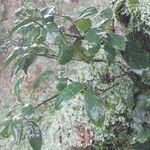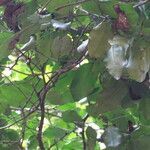A large tree. It grows 35 m tall. It keeps its leaves throughout the year. The crown has short branches. The bark is dark grey with fine cracks. The leaves are alternate and narrowly oval. They are 7-12 cm long by 3-4 cm wide. They are shiny dark green. The edges are often wavy. Young leaves are red. The flowers are small and grow in the axils of leaves. They can occur singly or in small clusters. They are creamy white to yellow. They have a scent. The fruit is round and fleshy. It is held in a lobed cup. It is yellowish green and turns blue to black when ripe. It is 1.4 cm long by 1 cm wide. There is usually one seed that is 9 mm long by 6 mm wide.
Leaves subcoriaceous, drying grey–green or blackish; lamina 3 x 1·2–12 x 4 cm., elliptic, oblanceolate–elliptic or lanceolate–elliptic, apex obtuse to shortly and bluntly subacuminate, rarely distinctly acuminate; lower surface glabrescent; lateral nerves in 5–12 pairs; venation prominent and closely reticulate on both surfaces.
D. abyssinica, which is widespread in tropical Africa, is moderately variable in leaf–shape and size. This variation is too diffuse to justify the recognition of infra–specific taxa except for subsp. chapmaniorum, a consistently small–leaved variant in Malawi and adjacent parts of Zambia and Mozambique.
Calyx 0·6 cm. long, cyathiform, glabrous outside, finely strigulose towards the base inside, divided almost to the base; lobes 3–4 up to 0·6 x 0·6 cm., suborbicular, sometimes apiculate, strongly imbricate.
Ovary 0–4 x 0–2 cm., conoidal, glabrous, gradually merging into the short undivided style; locules 6, uniovulate; stigmatic lobes, 3, about 0·1 cm. long, ascending.
Calyx 0·2 cm. long, shallowly cyathiform, with 3–4 short, broadly deltate lobes, glabrous outside except for a few minute marginal hairs, glabrous inside.
Male floiaers axillary and ramuligerous, in contracted 1018–flowered cymes; peduncle 0·1 cm. long; pedicels 0–1 cm. long, fulvous–setulose.
Staminodes 3–4 glabrous, 0–2 cm. long, filiform, exserted, attached to the throat of the corolla and alternating with the lobes.
Corolla 0·5–0·6 cm. long, sub–rotate, glabrous; tube 0·15 cm. long; lobes 3–4, 0·45 x 0·3 cm., broadly elliptic, apex obtuse.
Female flowers axillary or ramuligerous, in (1–2) 3–5(8)–flowered fascicles; pedicels 0·2 cm. long, fulvous–setulose.
Stamens 10–15, 0·2–0·4 cm. long; anthers lanceolate–apiculate, sparsely setulose towards the apex.
Small, medium–sized or large tree up to 36 m. high, but sometimes flowering as a shrub 2 m. high.
Seed(s) 1 (very rarely 2), 0·9 x 0·6 cm., globose to sub–ellipsoid, black; endosperm smooth.
Fruit up to 1·4 x 0·9 cm., glabrous, ellipsoid or subglobose, style persistent.
Bark dark grey or blackish, rough, reticulate and exfoliating on old trees.
Fruiting calyx scarcely accrescent, c. 0·7 cm. long, becoming patelliform.
Corolla slightly shorter than the calyx, otherwise as in male.
Bark thin, dark, rough, reticulate and scaling on old trees
Medium-sized evergreen forest tree, to 90 (-120) ft. high
Long straight slender bole and small dense crown
Pistillode 0·1 cm. long or absent, glabrous.
Slash black outside, bright yellow inside
Bole long, straight, slender.
Flowers cream
Fruit black.




